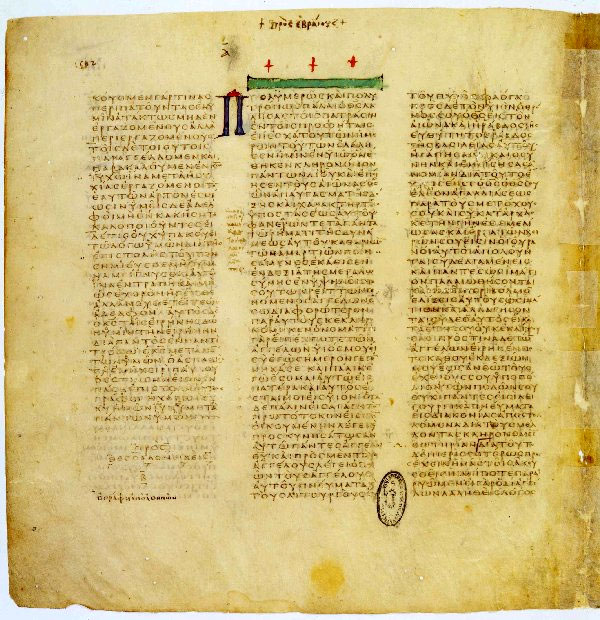
🧭 Introduction
The Septuagint (LXX) is the ancient Greek translation of the Hebrew Bible, created in Alexandria, Egypt between the 3rd and 2nd centuries BCE. It was originally produced so that Greek-speaking Jews — especially those living outside Israel — could read the Scriptures in their everyday language.
It’s important to note that the Septuagint is not a single ancient manuscript. Rather, it refers to the first major Greek translation of the Hebrew Bible, which was copied and circulated over centuries. Today, we have thousands of Septuagint manuscripts and fragments, ranging from small papyrus scraps to nearly complete codices. Each copy confirms the text’s consistency over time, demonstrating how faithfully the translation — and the underlying Hebrew Scriptures — has been preserved.
By the time of Jesus, the Septuagint was the common version of the Old Testament used throughout the Jewish world. In fact, when Jesus and the apostles quote the Old Testament in the Gospels, they often use the Septuagint wording. The survival of these manuscripts and fragments across centuries highlights the enduring reliability and preservation of the biblical text.
📜 Discovery and Manuscript Evidence
How many manuscripts survive today?
- Scholars estimate we have over 2,000 surviving Septuagint manuscripts and fragments, ranging from tiny scraps to nearly complete Bibles.
- Together, these manuscripts preserve almost the entire Old Testament in Greek, though no single copy contains everything perfectly intact.
Major Codices (big bound manuscripts):
- Codex Vaticanus (B) – 4th century CE
- Codex Sinaiticus (א) – 4th century CE
- Codex Alexandrinus (A) – 5th century CE
These are the three great ancient Bibles that give us nearly complete copies of the Greek Old Testament.
Papyrus Fragments:
- Papyrus is a type of paper made from reeds in Egypt — the “notebook paper” of the ancient world.
- These fragments are usually small scraps, dating from the 2nd–3rd centuries CE, but they preserve pieces of books like Deuteronomy and the Psalms. Even though tiny, they prove the Septuagint was in circulation very early.
Dead Sea Scrolls (Qumran):
- Found in caves near the Dead Sea (1947 onward).
- Most are in Hebrew or Aramaic, but a few are in Greek, including pieces of Exodus, Jeremiah, and Leviticus.
- This shows that Greek translations of the Bible were even read in Judea itself during the Second Temple period (~516 BCE – 70 CE).
Why this matters:
These manuscripts and fragments show that the Septuagint was widely read by both Jews and the first Christians. Together, they preserve the text of the Old Testament in Greek with remarkable consistency, confirming how carefully the Scriptures were copied and passed down through history.
📖 Biblical Significance
The Septuagint became the version of Scripture most often quoted in the New Testament. Scholars estimate that roughly two-thirds of Old Testament quotations in the NT follow the LXX wording rather than the later Masoretic Text. Importantly, the earliest manuscripts of the Septuagint containing these readings predate or closely follow Christianity, confirming that they were part of the original Greek translation, not later Christian additions.
Examples include:
- Isaiah 7:14 – LXX uses parthenos (“virgin”), quoted directly in Matthew 1:23 about the birth of Jesus.
- Earliest manuscript evidence: Papyrus 967 (3rd century BCE, Isaiah fragments), showing this translation existed well before the Gospels were written.
- Psalm 22:16 – LXX reads “they pierced my hands and my feet,” echoing crucifixion imagery, while the Hebrew Masoretic Text reads “like a lion.”
- Earliest surviving manuscripts: Papyrus Chester Beatty IX–X (2nd century CE) and Codex Vaticanus (4th century CE).
- Note: Although no pre-Christian manuscript of this verse survives, the reading “they pierced my hands and my feet” is consistently present in all early Greek Septuagint manuscripts that contain Psalm 22, including 2nd-century CE papyri and 4th-century codices. Its uniform presence across multiple, geographically dispersed copies indicates that it was part of the established Septuagint tradition well before New Testament authors cited it. The weight of this evidence makes it extremely unlikely that the wording was a later Christian interpolation.
- Jeremiah – The LXX version of Jeremiah is shorter and arranged differently than the Masoretic Text.
- Earliest manuscript evidence: Greek fragments among the Dead Sea Scrolls (2nd–1st century BCE), confirming that this alternate version existed centuries before Jesus.
Thus, the Septuagint is not only a translation but also a witness to early Hebrew textual forms, providing insight into how Scripture was understood before and during the time of Jesus. These manuscripts demonstrate that the Greek Old Testament readings quoted in the New Testament were already circulating and authoritative in the Jewish world, long before Christian authors preserved them.
📜 Historical Significance
The Septuagint holds immense historical value. It was the Scripture of the early church — the apostles, evangelists, and early church fathers all relied on it as their Old Testament. At the same time, it preserves textual variants of the Hebrew Bible that would otherwise be lost, giving us a window into the diversity of Jewish texts before the Masoretic Text was standardized.
The Septuagint also played a central role in shaping Christian theology. Many messianic prophecies and doctrinal interpretations in the New Testament are rooted in the LXX’s wording, showing that the Greek translation influenced how Scripture was understood and applied in the early church.
⚖️ Authenticity and Scholarly Debate
Scholars agree that the Septuagint represents a legitimate Jewish translation tradition. Most of the text aligns closely with the Hebrew Bible, but some books are more literal while others are paraphrastic or interpretive. A few passages have been debated, particularly sections involving a few of the many messianic or prophetic statements, such as parts of Psalms or Jeremiah, where scholars consider whether differences reflect older Hebrew readings or translator choices.
Importantly, these debated texts existed in Greek centuries before Jesus, as evidenced by early Septuagint manuscripts and fragments. This means that even the passages critics sometimes highlight were already circulating in the Jewish world and cannot be explained as later Christian additions. The Dead Sea Scrolls further show that in several cases, the LXX preserves readings closer to earlier Hebrew traditions than the later Masoretic Text.
While minor debates remain about a few passages, the vast majority of the Septuagint is consistent with the Hebrew Bible, and the existence of pre-Christian Greek copies of prophetic passages strongly supports its historical reliability. This demonstrates that the Septuagint is not only a faithful translation but also a reliable witness to how Scripture was understood in the centuries leading up to the New Testament.
🏛️ Why This Discovery Matters: Historical Validation
The Septuagint is more than just a translation — it is a living witness to how Jews and early Christians read and interpreted Scripture in antiquity. It helps explain why New Testament authors quote the Old Testament the way they do.
The LXX also demonstrates the continuity of God’s Word across languages, cultures, and centuries. From Greek-speaking Jews in Alexandria to early Christian communities, the Septuagint shows that the biblical message transcended Hebrew, Greek, and eventually every language in the world.
Archaeology and manuscript discoveries — from papyrus fragments and major codices like Vaticanus and Sinaiticus to Greek texts among the Dead Sea Scrolls — continue to confirm that the Bible’s testimony is rooted in real history, not legend.
📚 References & Image Credits
- Britannica. “Septuagint.” Available here.
- Center for the Study of New Testament Manuscripts. “Codex Sinaiticus and Vaticanus.” https://csntm.org/
- Tov, Emanuel. Textual Criticism of the Hebrew Bible. Fortress Press, 2012.
- Dead Sea Scrolls Digital Project. Israel Museum, Jerusalem.
- Image: Codex Vaticanus B, 2 Thessalonians 3:11–18, Hebrews 1:1–2, 2 – Wikimedia Commons, public domain.

Leave a Reply